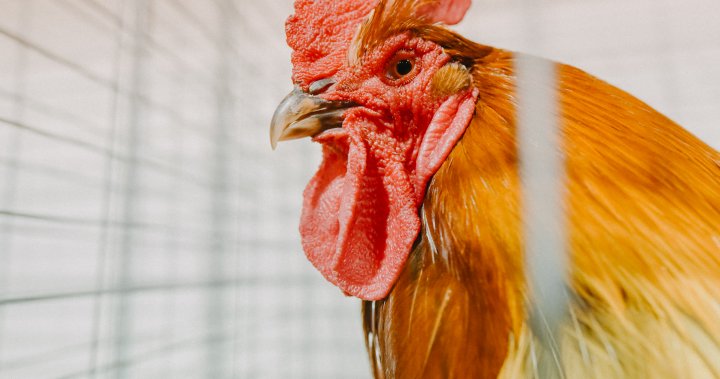Bird flu’s momentum in Canada worries experts: ‘Potential to become a pandemic’ – National | Globalnews.ca
Bird flu, or avian flu, continues to spread across Canada, leaving some experts worried about its potential to become more transmissible among humans, and potentially sparking another pandemic.
The current outbreak circulating North and South America is known as H5N1 clade 2.3.4.4b. It has killed record numbers of birds and infected mammals.
Read more:
Avian flu outbreak affects 500K birds in Saskatchewan, concerns researchers and farmers
Although human cases remain rare, Shayan Sharif, a professor and associate dean with the Ontario Veterinary College at the University of Guelph, warned the virus is “gathering momentum” and becoming more of a human threat.
“Various pieces of the puzzle are coming together for this virus to become transmissible among humans,” he told Global News. “And this particular virus has the potential to become a pandemic virus, and if it does, then we have to be absolutely ready because the fatality rate of this virus could be far greater than what we saw for COVID-19.”
The key to helping stop this virus from spreading into something more dangerous is making sure the virus does not have a chance to adapt so it cannot transmit to people in the first place, said Matthew Miller, director of DeGroote Institute for Infectious Disease Research at McMaster University.
While he didn’t mention the possibility of a pandemic specifically, Miller warned there’s an urgency in making sure health officials act proactively to ensure the virus does not mutate and adapt.

This strain of bird flu first showed up in Canada in December 2021. Since then, Sharif said it has gone through “three waves.” The first was at the beginning of March 2022, the second around August last year and he said Canada is currently in the third wave, adding “we aren’t in the height of the wave, but only the very beginning.”
Data compiled by the Canadian Food Inspection Agency, shows there are 1,829 confirmed and suspected cases of bird flu in animals overall in Canada as of Friday. The majority of cases are in Quebec (367), Alberta (268) and Saskatchewan (243).
What is bird flu and why is it spreading now?
Some flu viruses mainly affect people, but others chiefly occur in animals. For example, there are flus that occur in dogs, as well as pig – or swine – flu viruses. Then there are avian viruses that spread naturally in wild aquatic birds like ducks and geese, and then to chickens and other domesticated poultry.
The bird flu virus drawing attention today –Type A H5N1– was first identified in 1959 by investigators looking into a flu outbreak in chickens in Scotland. Like other viruses, it has evolved over time, spawning newer versions of itself.
By 2007, the virus was found in more than 60 countries, including Canada.
Over the last year, there has been a large virus outbreak in waterfowl — such as geese — that migrate from Europe to North and South America, he explained. And as these birds migrate, they spread the virus, which is why outbreaks are starting to spread in the U.S. and Canada, Miller said.
There is also more spillover to other wildlife, including seals and skunks, as well as livestock on mink farms.

For example, last month eight skunks that were found dead in the Vancouver area tested positive for the H5N1 avian influenza. B.C. health officials said the skunks may have contracted the virus by eating infected wild birds.
And last summer, Quebec researchers said bird flu had been detected in at least two species of seals as an unusually high number of these mammal’s carcasses were washing up on the province’s shorelines.
This is because the virus is primarily a gastrointestinal infection in birds, Miller said, so it can spread through their feces. However, it can also kill the bird, so when scavenger animals like skunks eat an infected bird, they can also get the virus.
Is the bird flu a concern for humans?
The risk of viral transmission to humans remains low, according to Health Canada.
“The risk of avian flu infection is low for the general public who has limited contact with infected animals; those with close contact to infected animals are at increased risk, and should take appropriate precautions,” Health Canada said in an email to Global News Friday.
The virus normally spreads among bird species but sometimes can jump from bird to human, as was the recent case in Cambodia, where an 11-year-old girl, who lived near a conservation area, reportedly died from the virus.
Global News asked Health Canada whether it was concerned bird flu could become a pandemic, and the department said the “circulating virus is being monitored on an ongoing basis to look for genetic changes that could indicate it is developing the ability to transmit more efficiently in mammals.”
Read more:
Bird flu numbers are ‘unprecedented.’ Here’s what experts say about the risk to humans
Although the overall transmission risk is low, the virus does have high consequences for humans, Miller said, adding that its mortality rate is on par with viruses like Ebola.
“This is a much, much, much deadlier virus than COVID-19,” Miller said. “When these viruses do cause human infections, the mortality rate can be as high as 50 per cent, which is obviously a very scary number.”
The death rate for COVID-19 is a little more than one per cent in Canada, according to Our World Data.
Because bird flu is so transmissible, Miller warns that if humans encounter a dead bird or other wildlife species, the risk comes from handling the animal, so people need to avoid contacting it at all costs.
However, there isn’t a “perceptible risk” of getting the virus by eating chicken or turkey meat, Miller added, as the virus would be killed when the meat was cooked.
Will there be an avian flu vaccine?
It’s almost “certain” that pharmaceutical manufacturers are making a stockpile of vaccines for this type of H5N1, Miller said.
The good news about influenza, Miller explained is that “it’s actually relatively simple to use the technology that we use to make current seasonal vaccines and adapt it to make vaccines for bird flu.”
There are currently a number of seasonal flu vaccine manufacturers who are capable of making bird flu vaccines (for both animals and humans) using their existing infrastructure, he added.
At least three pharmaceutical companies, GSK, CSL Seqirus, and Moderna are developing vaccines that match the circulating subtype H5N1 and are close to testing it on humans, according to Reuters.

Because manufacturers may be able to quickly turn around a bird flu vaccine, Miller said this “puts us in a much different situation than we were in with COVID-19.”
“Prior to the pandemic, not only did we not have the infrastructure to produce COVID vaccines, but we also didn’t have vaccines against coronaviruses that were used in humans at all. So we are better prepared in the flu space,” he said.
In Canada, there is no current vaccine that can be used for poultry or humans. But the government is maintaining “pandemic vaccine preparedness contracts in the event of a pandemic (including one caused by avian influenza),” Health Canada told Global News.
Currently, Canadians may not be at the stage for mass inoculations of the general public, but it should be considered for those at high risk, Miller said.
This includes poultry farmers, veterinarians and wildlife workers who may encounter the virus in animals due to the nature of their jobs.
‘Adaption to humans’ a concern
The most concerning part of the bird flu has been its ability to transmit and adapt to mammals, Sharif said.
“That could be a prelude to adaptation to humans. And that’s precisely what we don’t want this virus to do, which is to become adapted to humans and then eventually become transmissible within human populations,” he added.
Last month, Tedros Adhanom Ghebreyesus, the World Health Organization’s director-general, said that avian influenza’s spillover to mammal species must be monitored closely, but added the risk to humans is still rare.
Read more:
Why bird flu is always a ‘red flag’: Canadian health care experts break it down
Sharif said governments should start erring on the side of caution.
“Many of these viruses are out there in the environment, but we either don’t know them, we don’t monitor them,” Sharid said. “And as a result of that, we have no idea at what point in time we need to gain all the necessary requirements in order to stop it from transmitting to other animals or to humans,” he said.
It may not be time to panic, he added, but it is time to “be ready for a potential future pandemic,” in case the virus evolves and spreads more easily between people.
— with files from the Associated Press and Reuters
For all the latest health News Click Here




